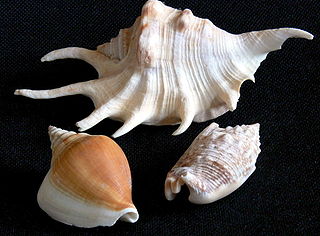
Acteonidae, common name the "barrel bubble snails", is a family of small sea snails, marine gastropod mollusks of the informal group Lower Heterobranchia.

Strombidae, commonly known as the true conchs, is a taxonomic family of medium-sized to very large sea snails in the superfamily Stromboidea. The term true conchs, being a common name, does not have an exact meaning. It may refer generally to any of the Strombidae but sometimes is used more specifically to include only Strombus and Lambis. The family currently includes 23 extant, and 10 extinct genera.

Strombus is a genus of medium to large sea snails, marine gastropod molluscs in the family Strombidae, which comprises the true conchs and their immediate relatives. The genus Strombus was named by Swedish Naturalist Carl Linnaeus in 1758. Around 50 living species were recognized, which vary in size from fairly small to very large. Six species live in the greater Caribbean region, including the queen conch, Strombus gigas, and the West Indian fighting conch, Strombus pugilis. However, since 2006, many species have been assigned to discrete genera. These new genera are, however, not yet found in most textbooks and collector's guides.

The Stromboidea, originally named the Strombacea by Rafinesque in 1815, is a superfamily of medium-sized to very large sea snails in the clade Littorinimorpha.

Harpa, common name the "harp snails", is a genus of large predatory sea snails, marine gastropod mollusks in the family Harpidae.

Tibia is a genus of large sea snails, marine gastropod mollusks.

Strombus pugilis, common names the fighting conch and the West Indian fighting conch, is a species of medium to large sea snail, a marine gastropod mollusk in the family Strombidae, the true conchs.

Lobatus raninus, common name the hawk-wing conch, is a species of medium to large sea snail, a marine gastropod mollusk in the family Strombidae, the true conchs.

Oxymeris crenulata, common name crenulate auger, is a species of sea snail, a marine gastropod mollusk in the family Terebridae, the auger snails.

Terebra anilis is a species of sea snail, a marine gastropod mollusk in the family Terebridae, the auger snails.

Lobatus goliath, previously known as Eustrombus goliath and Strombus goliath, common name the goliath conch, is a species of very large edible sea snail, a marine gastropod mollusk in the family Strombidae, the true conchs. L. goliath is one of the largest mollusks of the Western Atlantic Ocean, and also one of the largest species among the Strombidae. It was once considered endemic to Brazil, but specimens have also been recently found in the waters of Barbados. Brazilian common names for this species include búzio de chapéu or búzio, and búzio de aba or buzo in. L. goliath is considered closely related to the queen conch, Lobatus gigas.

Phos senticosus, common name Common Pacific Phos or Thorny Phos, is a species of sea snail, a marine gastropod mollusk in the family Buccinidae, the true whelks.

Nassarius arcularia, the casket nassa or the little box dog whelk, is a species of sea snail, a marine gastropod mollusk in the family Nassariidae, the Nassa mud snails or dog whelks.

Tritia corniculum, common name the horn nassa, is a species of sea snail, a marine gastropod mollusk in the family Nassariidae, the Nassa mud snails or dog whelks.

Phrontis vibex, common name the bruised nassa, is a species of sea snail, a marine gastropod mollusk in the family Nassariidae, the Nassa mud snails or dog whelks.

Harpa amouretta, common name the lesser harp, is a species of sea snail, a marine gastropod mollusk in the family Harpidae, the harp snails.

Harpa harpa, common name the true harp or the noble harp, is a species of sea snail, a marine gastropod mollusk in the family Harpidae, the harp snails.
Terebellum terebellum, common name the Terebellum conch, is a species of sea snail, a marine gastropod mollusk in the family Seraphsidae, the true conchs.

Strombus gracilior, common names the Eastern Pacific fighting conch, or the Panama fighting conch, is a species of medium to large sea snail, a marine gastropod mollusk in the family Strombidae, the true conchs.

Rimellopsis powisii, common name Powis's tibia, is a species of large sea snail, a marine gastropod mollusks in the family Rostellariidae within the Stromboidea, the true conchs and their allies.

















